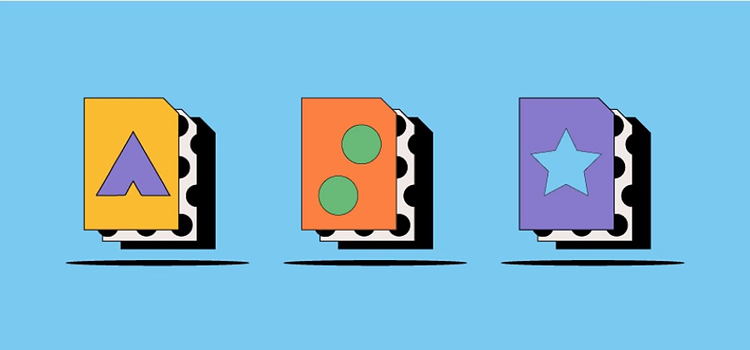DESIGN
Vector files.
The vector file format is one of two main image types you’ll encounter (along with the raster file format) when working with digital photos, graphics, logos and other imagery. Find out if vector files are the best option for you by discovering how they work, the different file extensions available and their advantages and disadvantages for digital projects.

https://main--cc--adobecom.hlx.page/cc-shared/fragments/seo-articles/get-started-notification-blade
What is a vector file?
Let’s take a step back before actually defining the vector file. When you work on any digital project, you’ll encounter two distinct types of image files — raster and vector. They’re formed in different ways and are better suited to some projects than others.
Raster files are composed of a fixed number of square pixels. This means raster files can become distorted if you resize them beyond the amount of space the pixels were meant to fill.
Vector images don’t use pixels. They’re created with mathematical equations, lines and curves — using points fixed on a grid — which means images can be made infinitely larger (or smaller) without losing resolution. Basically, vectors don’t lose quality when resized.
At the same time, don’t confuse either raster or vector formats with RAW files, which are unaltered, uncompressed images made up of direct data taken from a camera’s sensors. All three offer their own specific advantages, disadvantages and ultimately, use cases.
What are vector files used for?
The vector format is handy when you need high-quality graphics that can easily resize to different scales. Since they’re created using mathematical formulas, vector files won’t become fuzzy or distorted — no matter how large or small you make them.
So, what is vector typically used for? Digital illustrations and company logos frequently take this form if the graphic needs to be sized up or down for a variety of promotional materials. From bite-sized business cards to T-shirts and posters, a logo saved in vector format won’t lose its resolution.
The most common types of vector file are AI (Adobe Illustrator), EPS (Encapsulated PostScript), PDF (Portable Document Format) and SVG (Scalable Vector Graphics).
Advantages and disadvantages of vector files.
There are both pros and cons to using vector images over the raster format.
Advantages of vector images.
Some of the major benefits of vector files include:
- Infinite resolution.
There’s virtually no limit on how big you can make a vector image without losing its resolution. In contrast, raster files only maintain their resolution when fit to a specific size. The bigger you stretch them, the more the quality can decline. - Lighter file sizes.
By avoiding blocks of pixels, vector files tend to be more lightweight than raster images such as photos, which can feature lots of camera data. - Plenty of design features.
You can add shapes, text, different colours and filters to create unique illustrations and designs — plus, you can easily go back and edit over and over again.
Disadvantages of vector images.
These are some of the disadvantages of using vector files:
- Less useful for complex photos.
Highly detailed digital photos may be better suited to the raster format, where their individual pixels can be edited. Vector files tend to be more suitable for graphics rather than photographs. - Compatibility issues.
You’ll need a vector-based design programme like Adobe Illustrator to open and work on vector files. Editing vectors in raster-based software can prove difficult. - Conversion difficulties.
It’s generally much harder to convert a raster image to a vector file than the other way around because it requires more computing power.
Vector files: frequently asked questions.
What types of images can vector files handle?
How can I spot a vector file?
How can I edit vector files?
What do the main vector file extensions mean?
- As the name suggests, .AI files are editable in Adobe Illustrator. They work well for logos.
- The .EPS extension is short for Encapsulated PostScript. This older file type handles two-dimensional graphics and text.
- The .PDF extension stands for Portable Document Format and helps make vector images print-ready and sharable.
- The .SVG (Scalable Vector Graphics) file type is designed to be used on the web.
Is it better to create logos as vector or raster images?
https://main--cc--adobecom.hlx.page/cc-shared/fragments/seo-articles/do-more-illustrator-color-blade